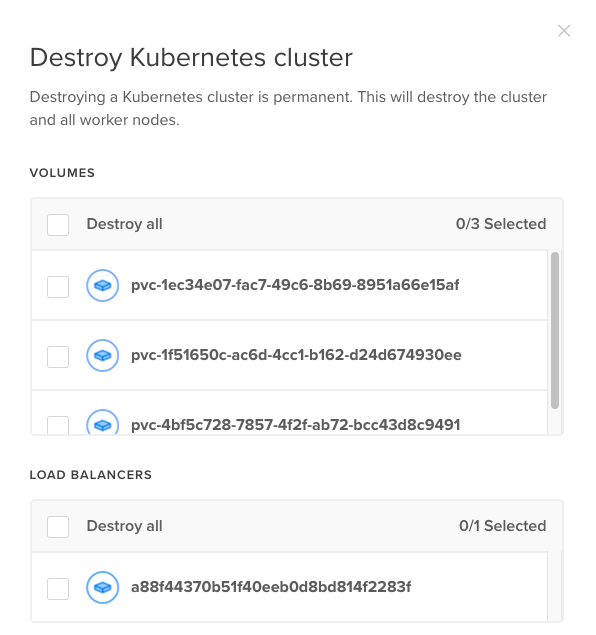Destroy a Cluster Using Automation
How to Delete a Kubernetes Cluster Using the DigitalOcean CLI
- Install
doctl, the official DigitalOcean CLI.
- Create a personal access token and save it for use with
doctl.
- Use the token to grant
doctl access to your DigitalOcean account.
- Finally, run
doctl kubernetes cluster delete. Basic usage looks like this, but you can read the usage docs for more details:
doctl kubernetes cluster delete <id|name>... [flags]
example-cluster:
doctl kubernetes cluster delete example-cluster
How to Delete a Kubernetes Cluster Using the DigitalOcean API
- Create a personal access token and save it for use with the API.
- Send a DELETE request to
https://api.digitalocean.com/v2/kubernetes/clusters/{cluster_id}.
cURL
Using cURL:
curl -X DELETE \
-H "Content-Type: application/json" \
-H "Authorization: Bearer $DIGITALOCEAN_TOKEN" \
"https://api.digitalocean.com/v2/kubernetes/clusters/bd5f5959-5e1e-4205-a714-a914373942af"
Go
Using Godo, the official DigitalOcean API client for Go:
import (
"context"
"os"
"github.com/digitalocean/godo"
)
func main() {
token := os.Getenv("DIGITALOCEAN_TOKEN")
client := godo.NewFromToken(token)
ctx := context.TODO()
_, err := client.Kubernetes.Delete(ctx, "bd5f5959-5e1e-4205-a714-a914373942af")
}
Ruby
Using DropletKit, the official DigitalOcean API client for Ruby:
require 'droplet_kit'
token = ENV['DIGITALOCEAN_TOKEN']
client = DropletKit::Client.new(access_token: token)
client.kubernetes_clusters.delete(id: 'bd5f5959-5e1e-4205-a714-a914373942af')
Python
Using PyDo, the official DigitalOcean API client for Python:
import os
from pydo import Client
client = Client(token=os.environ.get("DIGITALOCEAN_TOKEN"))
resp = client.kubernetes.delete_cluster(cluster_id="da8fda8")
Destroy a Cluster Using the Control Panel
To destroy a cluster, go to the Kubernetes page in the control panel. From the cluster’s More menu, select Destroy and click Destroy. In the Destroy Kubernetes cluster dialog box, select the resources, such as load balancers and volumes, associated with the cluster to delete them automatically when the cluster is deleted. Enter the name of the cluster, then click Destroy to confirm.

You can also delete the associated load balancers and volumes manually from the control panel after the cluster is destroyed. You will continue to be billed until the resources are destroyed .
You can also use doctl or the API to delete the associated resources automatically when you destroy a cluster.
